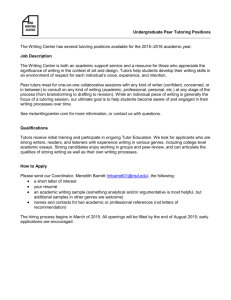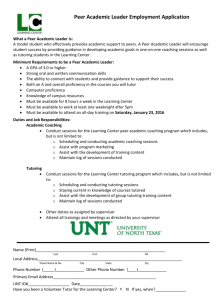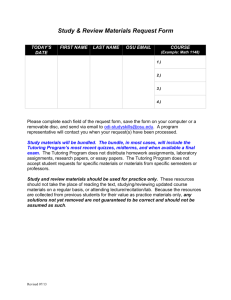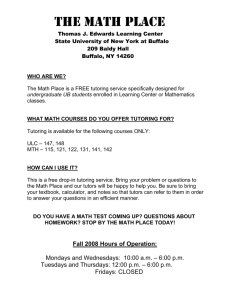- UNIMAS Institutional Repository
advertisement
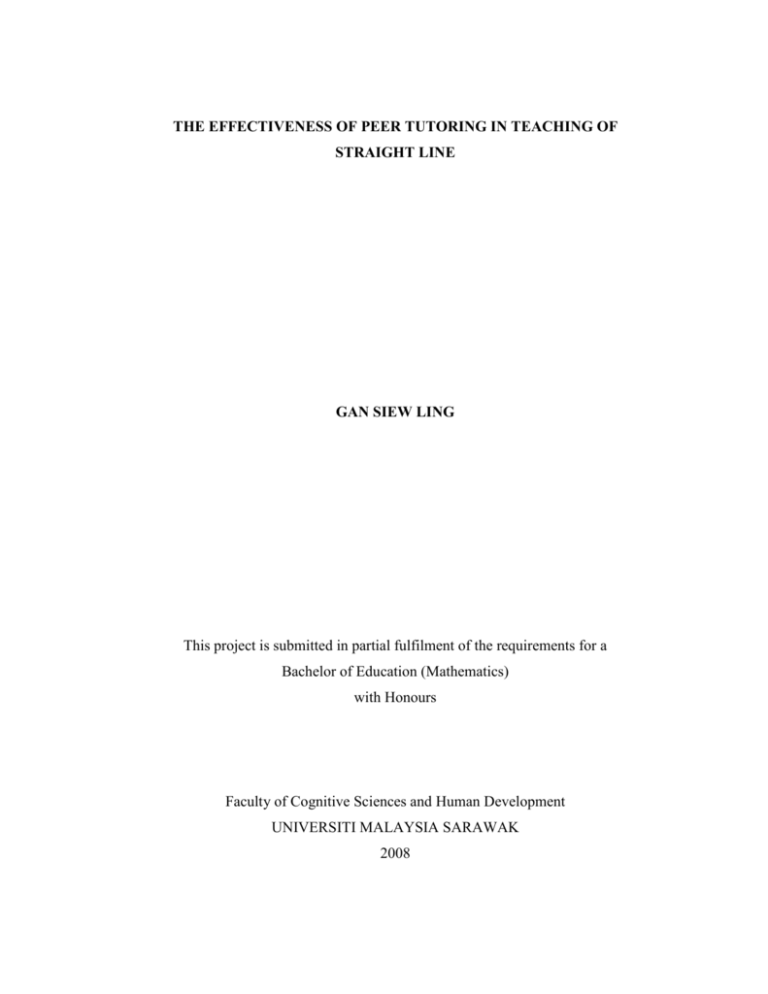
THE EFFECTIVENESS OF PEER TUTORING IN TEACHING OF STRAIGHT LINE GAN SIEW LING This project is submitted in partial fulfilment of the requirements for a Bachelor of Education (Mathematics) with Honours Faculty of Cognitive Sciences and Human Development UNIVERSITI MALAYSIA SARAWAK 2008 This project entitled “The effectiveness of peer tutoring in teaching of straight line” was prepared by Gan Siew Ling and submitted to the Faculty of Cognitive Sciences and Human Development in partial fulfilment of the requirements for a Bachelor of Education (Mathematics) with Honours. Received for examination by: -------------------------------------------(Associate Prof. Dr Hong Kian Sam) Date: -------------------------Grade ACKNOWLEDGEMENT After months of hard work, I thank God that I finally completed my Final Year Project Paper. Many people had contributed and assisted me during my research and also gave me the much needed moral support. First of all, I would like to express my appreciation to my supervisor, Associate Professor Dr. Hong Kian Sam for his advice and guidance throughout the time it took me to complete my project paper. Without his help, I am sure that my project paper would not be completed in time. Secondly, I would also like to express my gratitude to my course mates, such as George Tan Geok Shim, Kueh Su Li, Hii Yung Ing, Chhan Siew Lan, Ting Sing Siong, Ting Jack Yew and Lau Siew Bey, for their assistance and moral support. I would also like to express my gratitude to the principal, the teachers and the Form Four students of SMK Siburan, for their cooperation and willingness to take part in my research. The time spent and efforts given will not be forgotten. Lastly, I would like to thank my family, lecturers and friends for their support and guidance throughout my study in Unimas. i ABSTRACT THE EFFECTIVENESS OF PEER TUTORING IN THE TEACHING OF STRAIGHT LINE Gan Siew Ling The main purpose of this study was to examine the effectiveness of peer tutoring in teaching Straight Line in secondary school. The study also investigated the effects of peer tutoring on interest in mathematics, perceptions of instructional method and mathematics self-efficacy. In addition, the study also looked at gender differences for the various variables. The study was carried out using a pretest-posttest quasiexperimented design with a control group. The treatment group was taught using peer tutoring whereas the control group was taught using traditional instruction method. Two form four classes were randomly assigned to be the treatment group and control group. The treatment group and control group consisted of 33 (n = 11 male, n = 22 female) and 34 (n = 12 male, n = 22 female) students respectively. The instruments used in the study were a pretest, a posttest and a questionnaire. The pretest was given to students before the treatment was started. After two weeks of treatment, the posttest and questionnaire were administered to the students. Data collected from the pretest, posttest and questionnaire were analysed using SPSS. Results of the study showed that students who had received peer tutoring scored higher in the gain scores compared to those had received traditional instruction. Thus, peer tutoring was found to be more effective than the traditional instruction method in increasing students’ score from the pretest to the posttest. The findings also suggested that female students performed better than the male students in mathematics achievement. However, there were no interaction effect between gender and instructional method. Students in the ii peer tutoring groups showed higher interest in mathematics and mathematics selfefficacy. Students also showed more positive perceptions toward peer tutoring compared to traditional instruction method. In the peer tutoring group, female students showed higher interest in mathematics than male students. However, for the peer tutoring group, gender differences were not evident for mathematics selfefficacy and perceptions toward peer tutoring. Thus, it could be concluded that peer tutoring is a potentially effective instructional method that could be practiced in the mathematics teaching and learning in Malaysia in tandem with other existing instructional method. iii ABSTRAK KEBERKESANAN PENTUTORAN RAKAN SEBAYA DALAM PENGAJARAN GARIS LURUS Gan Siew Ling Tujuan utama kajian ini adalah untuk mengkaji keberkesanan pentutoran rakan sebaya dalam pengajaran topic garis lurus di sekolah menengah. Kajian ini juga menyelidik kesan pentutoran rakan sebaya ke atas minat dalam matematik, persepsi terhadap kaedah pengajaran dan efikasi diri dalam matematik. Tambahan lagi, kajian ini juga meninjau kesan perbezaan jantina terhadap pelbagai pembolehubah. Kajian ini menggunakan rekabentuk ujian pra-pasca kuasi-eksperiment dengan satu kumpulan kawalan. Kumpulan kajian diajar menggunakan pentutoran rakan sebaya manakala kumpulan kawalan diajar menggunakan kaedah pembelajaran tradisional. Dua kelas tingkatan empat diagihkan secara rawak kepada kumpulan kajian dan kumpulan kawalan. Kumpulan kajian dan kumpulan kawalan masing-masing terdiri daripada 33 (n = 11 lelaki, n = 22 perempuan) dan 34 (n = 12 lelaki, n = 22 perempuan) pelajar. Instrumen yang digunakan dalam kajian ini adalah ujian pra, ujian pasca dan juga borang soal selidik. Ujian pra diberikan kepada pelajar sebelum kajian dimulakan. Selepas dua minggu kajian, ujian pasca dan borang soal selidik akan diserahkan kepada pelajar. Data yang dikumpul daripada ujian pra, ujian pasca dan borang soal selidik akan dianalisis menggunakan SPSS. Dapatan kajian menunjukkan bahawa pelajar yang telah menerima pentutoran rakan sebaya memperolehi markah lebih tinggi dalam pencapaian markah berbanding dengan mereka yang menerima pembelajaran tradisional. Oleh itu, pentutoran rakan sebaya iv didapati lebih efektif berbanding dengan kaedah pembelajaran tradisional dalam meningkatkan markah pelajar dari ujian pra kepada ujian pasca. Dapatan kajian juga mencadangkan bahawa pelajar perempuan mengatasi pelajar lelaki dalam pencapaian matematik. Namun demikian, tiada kesan interaksi antara jantina dan kaedah pengajaran. Pelajar dalam pentutoran rakan sebaya menunjukkan minat yang lebih tinggi dalam matematik dan efikasi diri dalam matematik. Pelajar juga menunjukkan persepsi positif terhadap pentutoran rakan sebaya berbanding dengan kaedah pembelajran tradisional. Dalam kumpulan pentutoran rakan sebaya, pelajar perempuan menunjukkan minat yang lebih tinggi dalam matematik daripada pelajar lelaki. Namun demikian, dalam kumpulan pentutoran rakan sebaya, perbezaan jantina tidak mendatangkan kesan kepada efikasi diri dalam matematik dan persepsi terhadap pentutoran rakan sebaya. Dengan yang demikian, dapat disimpulkan bahawa pentutoran rakan sebaya adalah berpotensi menjadi kaedah pengajaran yang efektif yang dapat dipraktikkan dalam pengajaran dan pembelajaran matematik di Malaysia bersama dengan kaedah pengajaran yang sedia ada. v TABLE OF CONTENTS ACKNOWLEDGEMENT i ABSTRACT ii ABSTRAK iv TABLE OF CONTENTS vi LIST OF TABLES x LIST OF FIGURES xiii CHAPTER 1: 1 INTRODUCTION 1.0 Introduction 1 1.1 Background of Study 2 1.2 Problem Statement 5 1.3 Research Objectives 7 1.4 Research Questions 8 1.5 Research Hypotheses 9 1.6 Research Framework 10 1.7 Significance of the Research 11 1.8 Limitation of the Research 11 1.9 Definition of Terms 12 1.9.1 Effectiveness 12 1.9.2 Peer Tutoring 12 1.9.3 Straight Line 13 1.9.4 Traditional Instruction Method 13 1.10 14 Summary CHAPTER 2: LITERATURE REVIEW 15 2.0 Introduction 15 2.1 Peer Tutoring 16 vi 2.2 Theoretical Perspective of Peer Tutoring 18 2.2.1 Constructivist Theory 18 2.2.2 Theory of Social Development 19 2.3 Characteristics of Peer Tutoring 20 2.3.1 Types of Peer Tutoring 20 2.3.2 Procedures of Peer Tutoring 23 2.3.3 Roles in Peer Tutoring 25 2.4 Advantages of Peer Tutoring 26 2.4.1 Academic Performance 27 2.4.2 Social Benefits 28 2.4.3 Economic Benefit 29 2.5 Effectiveness of Peer Tutoring in Non-Mathematics Subjects 29 2.6 Effectiveness of Peer Tutoring in Mathematics 31 2.7 Effectiveness of Peer Tutoring in Fostering Attitudinal and Socio-Emotional Outcomes 2.8 34 Gender Differences in Mathematics Performance and Instructional Method 2.9 2.10 37 Gender Differences in Students’ Interest in Mathematics, Perception of the Instructional Method and Mathematics Self-Efficacy 39 Summary 39 CHAPTER 3: RESEARCH METHODOLOGY 40 3.0 Introduction 40 3.1 Research Design 40 3.2 Research Participants 41 3.3 Research Instruments 41 3.3.1 Pretest and Posttest 41 3.3.2 Questionnaire 43 3.3.3 Process of Teaching and Learning using Peer Tutoring 43 vii 3.3.4 Process of Teaching and Learning using Traditional Instruction Method 44 3.4 Data Collection Procedures 44 3.5 Data Analysis 45 3.6 Summary 46 CHAPTER 4: FINDINGS 47 4.0 Introduction 47 4.1 Demographics of the Participants 47 4.2 Reliabilities of the Research Instruments 49 4.2.1 Questionnaire 49 4.2.2 Posttest 50 4.3 Research Findings 51 4.3.1 Effects of Instructional Methods and Gender on Achievement in the Topic of Straight Line 4.3.2 51 Differences in Students’ Interest in Mathematics between the Two Instructional Methods 4.3.3 53 Differences in Students’ Interest in Mathematics based on Gender in Peer Tutoring Group 4.3.4 61 Differences in Mathematics Self-Efficacy between the Two Instructional Methods 4.3.5 62 Differences in Students’ Mathematics Self-Efficacy based on Gender in Peer Tutoring Group 4.3.6 71 Differences in Perceptions of Instructional Method between the Two Instructional Methods 72 4.3.7 Differences in Students’ Perceptions of Peer Tutoring based on Gender 83 4.4 Summary 84 CHAPTER 5: 5.0 DISCUSSIONS AND CONCLUSIONS Introduction 85 85 viii 5.1 Summary of the Study 85 5.2 Summary of the Results 86 5.3 Discussions 87 5.3.1 Effects of the Instructional Method on Mathematics Performance 87 5.3.2 Effects of Gender on Mathematics Performance 88 5.3.3 Interaction between Gender and Instructional Methods on Mathematics Performance 89 5.3.4 Students’ Interest in Mathematics 89 5.3.5 Students’ Mathematics Self-Efficacy 90 5.3.6 Students’ Perceptions of the Instructional Methods 91 5.4 Implications of the Study 92 5.5 Suggestions for Future Studies 93 5.6 Summary 94 BIBLIOGRAPHY 95 APPENDICES 102 Appendix A : Pretest 102 Appendix B : Posttest 111 Appendix C : Questionnaire 120 Appendix D : Example of Lesson Plan for Peer Tutoring 123 Appendix E : Example of Lesson Plan for Traditional Instruction Method 128 ix LIST OF TABLES Table 3.1 Test Blue Print for Pretest and Posttest 42 Table 3.2 Data Analysis Carried Out in the Study 45 Table 4.1 Demographics of the Students 48 Table 4.2 Reliabilities Coefficients for Section B, Section C and Section D of the Questionnaires 50 Table 4.3 Reliability Coefficients for Posttest 50 Table 4.4 Results of Two-way ANOVA 52 Table 4.5 Means and Standard Deviations for the Gain in the Pretest and Posttest 52 Table 4.6 Means and Standard Deviations for Students’ Interest in Mathematics based on the Instructional Methods 55 x Table 4.7 Frequencies for Students’ Interest in Mathematics based on the Instructional Methods 59 Table 4.8 Independent t-test for Differences in Students’ Interest in Mathematics based on the Instructional Methods 61 Table 4.9 Independent t-test for Differences in Students’ Interest in Mathematics for the Peer Tutoring Group based on Gender 62 Table 4.10 Means and Standard Deviations for Students’ Mathematics Self-Efficacy based on the Instructional Methods 64 Table 4.11 Frequencies for Students’ Mathematics Self-Efficacy based on the Instructional Methods 69 Table 4.12 Independent t-test for Students’ Mathematics Self-Efficacy based on the Instructional Methods 71 Table 4.13 Independent t-test for Differences in Students’ Mathematics Self -Efficacy based on Gender in the Peer Tutoring Group 72 Table 4.14 Means and Standard Deviations for Perception of the Instructional Methods xi 75 Table 4.15 Frequencies for Students’ Perceptions of the Instructional Methods 81 Table 4.16 Independent t-test for Differences in Perceptions of the Instructional Methods 83 Table 4.17 Independent t-test of Differences in Students’ Perception of Peer Tutoring based on Gender. 84 xii LIST OF FIGURES Figure 1.1 Research Framework of the Study 10 xiii CHAPTER 1 INTRODUCTION 1.0 Introduction This chapter has been divided into ten main sections, which covers the Background of the study, Problem statement, Research objectives, Research questions, Research hypotheses, Research framework, Significance of the study, Limitation of study, Definition of terms and Summary. The background of the study section discusses the paradigm shift in education in the Malaysia context and a brief overview of studies regarding peer tutoring. The next four sections discuss the problem statement, research objectives, research questions and research hypotheses of the study. The research framework outlines the independent and dependent variables, and the relationships between these variables. The significance and limitation of the study are presented. The definitions of terms used in this study were also provided. The last section provides the summary of the chapter. 1 1.1 Background of Study The field of education has undergone a significant shift in thinking about the nature of human learning and the conditions that best promote the varied dimension of human learning (Applefield, Huber, & Moallem, 2001). Several researchers had suggested that human learn best if they repeat same behaviour several times and the theory behind this type of learning is the behaviourist. Therefore more recent research proposed a cognitive based learning approach and learning in most Western schools is viewed through the viewpoints of constructivist. According to Facey-Shaw and Golding (2005), cognitive theories of learning attempt to explain how instructors can use information to improve student learning. However, constructivist theory suggests that human learn better if there is an interaction between previous knowledge and new knowledge. Thus, there has been a paradigm shift in the designing of instruction; from behaviourist to cognitivist and now to constructivist (Cooper, 1993; cited in Applefield et al., 2001). In Malaysia, the education fraternity is advocating moving from the conventional lecturing pedagogy, which focuses on teacher-centred learning of facts acquisition and memory-oriented learning (Abdul Razak Hussain, Nor Hafeizah Hassan & Shahrin Sahid, 2001; cited in Ng, Kamariah Abu Bakar, Samsilah Roslan, Wong & Petri Zabariah Megat Abdul Rahman, 2005) to teaching and learning methods which emphasized student-centred learning (Hairul Ismail & Alexander, 2005) with involvement of active knowledge construction, as well as critical and creative thinking. The traditional teaching approach usually involve teacher starting the lesson by introducing the topic or concept, explaining it and then giving some worked examples. Lastly the teacher gives homework to the students. In this kind of learning situation, students are not able to construct their own understanding since they are not actively participating in the teaching and learning process. Students are not able to think creatively, innovatively and critically since they passively receive what has been taught to them. In addition, some students are not able to keep up with the 2 teacher’s pace. Hence, in order to promote active participation of students, teachers should adjust their teaching style to a more learner-centred one. One possible teaching approach is the peer tutoring approach. On the other hand, peer tutoring are “systematic, peer-mediated teaching strategies” (Rohrbeck, Ginsburg-Block, Fantuzzo & Miller, 2003) that consist of student partnerships, linking high achieving students with lower achieving students or those with comparable achievement, for structured reading and mathematics study sessions. Peer tutoring refers to situations where one child provides instructional assistance and guidance to another child (Tan, Cheah & Chong, 2005). According to Ornstein and Lasley II (2004), there are three types of pairing in peer tutoring, which are (1) students may tutor each other within the same class; (2) older students may tutor students in lower grades outside of class; or (3) two students may work together and help each other as equals on learning activities. The models derived from these three types of pairing in peer tutoring are class wide peer tutoring (CWPT), cross-age tutoring, peer-assisted learning strategies (PALS), small group tutoring, one-to-one tutoring and reciprocal peer tutoring (RPT). Peer tutoring is a type of peer-based learning that has received considerable attention in recent years (Tan et al., 2005). A significant amount of literature has focused on peer tutoring as a learning strategy to improve learning. However, most of the findings were based on Western context, for example studies conducted by Early (1998), Fuchs, Fuchs and Karns (2001), Fuchs, Fuchs, Mathes, and Martinez (2002a), Fuchs, Fuchs, Yazdian and Powell (2002b), Fueyo and Bushell (1998), Presbitero (2002), and Schwemmin (2004). Most of the findings from the studies, for example by Britz, Dixon, and McLaughlin (1989), Early (1998), Fuchs et al. (2001), Fuchs et al. (2002a), Fuchs et al. (2002b), Fueyo and Bushell (1998), Presbitero (2002) and Schwemmin (2004) showed that peer tutoring classes significantly outperformed control group classes in academic achievement. Additionally Fuchs, Fuchs, Mathes 3 and Simmons (1997) showed that peer tutoring lead to greater achievement gains than traditional instruction. In school, peer tutoring can be applied in various academic subjects such as mathematics, reading, English and spelling (DuPaul & Henningson, 1993 & Tan et al., 2005). Studies have shown that it helps to improve performance and maintain improvements (Britz et al., 1989, Early 1998, Fuchs et al., 2001, Fuchs et al., 2002b & Presbitero, 2002), increasing the time spent in relevant academic behaviours without adding additional burden on the teacher (Fueyo & Bushell, 1998) and allowing more opportunities to perform and relearn previously presented material (Tan et al., 2005), experiences that are essential but not always easily obtainable in the class (Giesecke, Cartledge, & Gardner, 1993; cited in Tan et al., 2005). Besides, some studies also showed low achievers and students with disabilities can benefit from peer tutoring (DuPaul & Henningson, 1993). Peer tutoring is not merely focusing on providing opportunities for both tutors and tutees improve their academic performance; peer tutoring has proved to be effective in improving attitudinal and socio-emotional outcomes of students. For example Griffin and Griffin (1997) pointed out that reciprocal peer tutoring (RPT) group showed a positive attitude towards RPT, however, research also showed that there was no significant difference in either test anxiety or academic self-efficacy between RPT and non-RPT groups. Topping, Campbell, Douglas and Smith (2003) on the other hand proved that a combination of cross-age peer tutoring with mathematics games was successful in increasing self-esteem for both tutors and tutees. Students have shown improvements in academic self-efficacy and learning self-efficacy (Topping et al, 2003) and intrinsic interest (Topping, Peter, Stephen & Whale, 2004) when using peer tutoring. 4 1.2 Problem Statement Education in Malaysia is moving from the traditional instruction method based on teacher-centred to active students’ participation in the learning process with the aim of achieving Vision 2020. In Vision 2020, Malaysia aims to produce a new generation of human resources that is productive, innovative and has critical and creative thinking skills. Therefore, in order to make the vision a reality, the Malaysian school culture is being transformed from one that is predominantly memory based to one that is informed, thinking, creative and empathetic (Hairul Ismail & Alexander, 2005). For example, Malaysia introduced the smart schools initiatives to create schools that adopt a learner-centred approach (Onn, 1998; cited in Hairul Ismail & Alexander, 2005) with students working cooperatively and collaboratively with each other on their classroom tasks and assignments with some guidance from teachers (Hairul Ismail & Alexander, 2005). In actuality, all schools in Malaysia have been or in the process of being upgrade to smart schools physically, yet in the most schools, the teaching and learning approaches used are still mainly of transmission mode from teachers to students. In reality, majority of the teachers in Malaysia are still not ready to use student-centred approaches, such as peer tutoring in their classroom. If this situation remains, then undoubtedly the nations’ vision 2020 would not be fulfilled. Malaysia’s education is very much examination-oriented (Sharifah Maimunah Syed Zin, n.d). There are many public examinations that a student has to pass in order to enter an institution of higher learning and to graduate with a degree and presumably get a good position in the society. According to Rude (2006), the mathematics instruction was still on rote memorization and students were not required to understand the root or logic of the theorems and formulas used in mathematics subject. Students therefore become passive receiver of knowledge transmitted by the teachers. Students do not have the opportunities to express their ideas or construct their own knowledge. Hassan Bohsan (1994) reported that Malaysian students are more reluctant to express their opinion in the class. Consequently, Malaysia is not 5 able to produce a new generation of human resources that is productive, innovative and has critical and creative thinking skills. Therefore, more teachers are beginning to use student-centred instruction such as cooperative learning, problem-based learning and group work in the classrooms instructions. In actuality, peer tutoring is not a new instruction approach, yet it is relatively uncommon in Malaysia. A number of studies (Britz et al., 1989, Early, 1998, Fuchs et al., 2001, Fuchs et al., 2002b, Fueyo & Bushell, 1998, Presbitero, 2002, Robinson, Schofield & Steers-Wentzell, 2005, Schwemmin, 2004) have shown that this student-centred teaching method has an impact on students’ achievement. However, most of the studies are in the Western context and there is a lack of such evaluative studies in Malaysia. Peer tutoring is not a well-known instructional strategy among Malaysian teachers and students. Malaysia schools have not fully embraced this instruction strategy in the process of teaching and learning. A possible reason is the lack of local context studies that showed peer tutoring as a useful instructional strategy to improve and enhance academic performance of students in Malaysia. Thus, as peer tutoring is a teaching approach that may not be common to teachers and students, the perceptions toward using peer tutoring in mathematics learning has not yet been fully research. Undoubtedly, it is difficult to introduce the student-centred instructional strategies, such as peer tutoring, into Malaysian education system (Hairul Ismail & Alexander, 2005) as students need time to adjust themselves to the new instructional approach. They may or may not accept peer tutoring regardless of its benefits to learning outcomes. In addition, the effectiveness of instructional methods could be affected by students’ gender. Hence, this research aimed to investigate the effectiveness of peer tutoring in teaching straight line for form four students. This research also intended to find differences in 6 mathematics achievement between female and male students in secondary school, as well as the interaction between the instructional methods (peer tutoring and traditional instruction) and gender on mathematics achievements. Additionally, the effects of peer tutoring on students’ interest in mathematics, students’ perceptions of instructional method and students’ mathematics self-efficacy also investigated in this study. The effects of gender differences on the students’ interest in mathematics, students’ perceptions of instructional method and students’ mathematics self-efficacy also investigated throughout this study. 1.3 Research Objectives The main research objective of this study was to investigate the effectiveness of peer tutoring in teaching the topic of straight line for form four students based on the Malaysia schools context. The specific objectives of this study were: 1. To investigate the differences in mathematics achievement between the groups of students taught using peer tutoring and traditional instruction method for the topic of straight line. 2. To determine the differences in students’ mathematics achievement based on gender. 3. To determine whether there were interaction effects between instructional methods (peer tutoring and traditional instruction method) and gender on mathematics achievement. 4. To find out the differences in students’ interest in mathematics between the groups of students taught using peer tutoring and traditional instruction method. 5. To determine the differences in students’ interest in mathematics based on gender in peer tutoring group. 7 6. To find out the differences in students’ mathematics self-efficacy between the groups of students taught using peer tutoring and traditional instruction method. 7. To determine the differences in students’ mathematics self-efficacy based on gender in peer tutoring group. 8. To find out the differences in students’ perceptions of the instructional methods between the groups of students taught using peer tutoring and traditional instruction method. 9. To determine the differences in students’ perceptions of peer tutoring based on gender. 1.4 Research Questions Based on the research objectives above, the following research questions were investigated in this study: 1. Were there any differences in mathematics achievement between the groups of students taught using peer tutoring and traditional instruction method for the topic of straight line? 2. Were there any differences in students’ mathematics achievement based on gender? 3. Were there any interaction effects between instructional methods (peer tutoring and traditional instruction method) and gender on mathematics achievement? 4. Were there any differences in students’ interest in mathematics between the groups of students taught using peer tutoring and traditional instruction method? 5. Were there any differences in students’ interest in mathematics based on gender in the peer tutoring group? 8 6. Were there any differences in students’ mathematics self-efficacy between the groups of students taught using peer tutoring and traditional instruction method? 7. Were there any differences in students’ mathematics self-efficacy based on gender in the peer tutoring group? 8. Were there any differences in students’ perceptions of the instructional methods between the groups of students taught using peer tutoring and traditional instruction method? 9. Were there any differences in students’ perceptions of peer tutoring based on gender? 1.5 Research Hypotheses Based on the research questions, this study had the following null hypotheses: H01: There were no significant differences in mathematics achievement between the groups of students taught using peer tutoring and traditional instruction method for the topic of straight line. H02: There were no significant differences in students’ mathematics achievement based on gender. H03: There were no interaction effects between instructional methods (peer tutoring and traditional instruction method) and gender on mathematics achievement. H04: There were no significant differences in students’ interest in mathematics between the groups of students taught using peer tutoring and traditional instruction method. H05: There were no significant differences in students’ interest in mathematics based on gender in the peer tutoring group. 9

